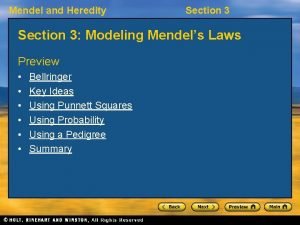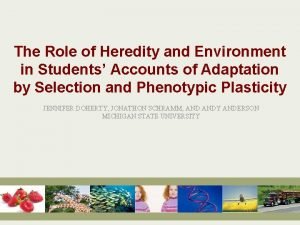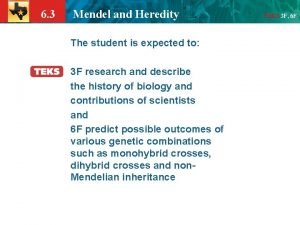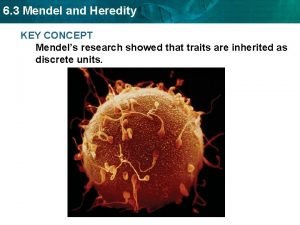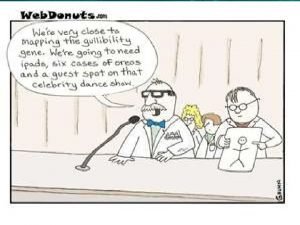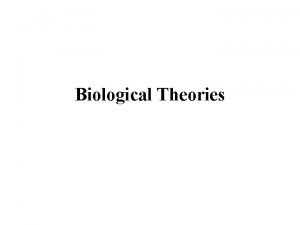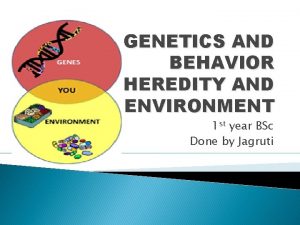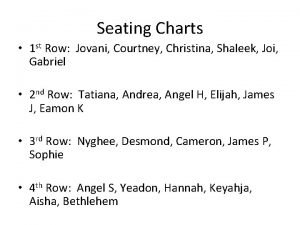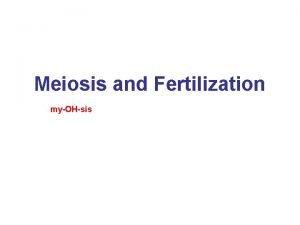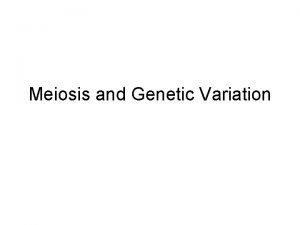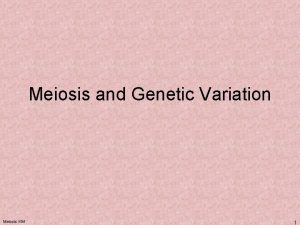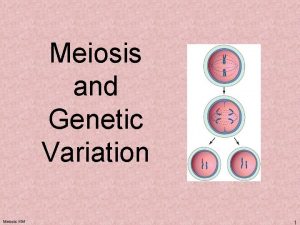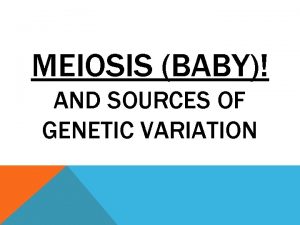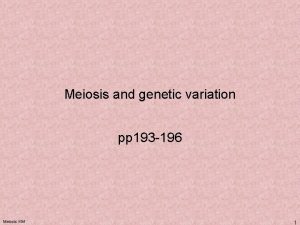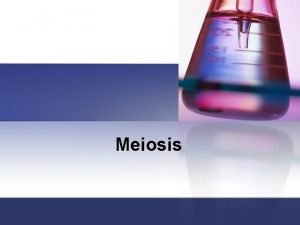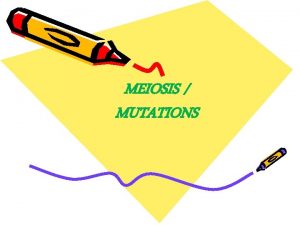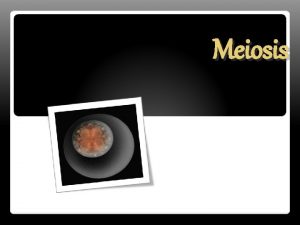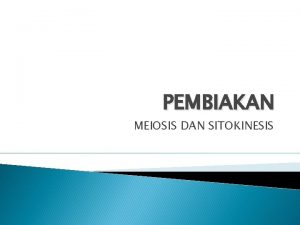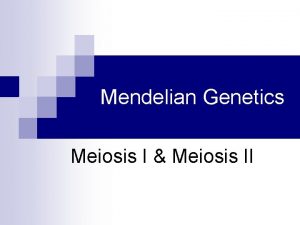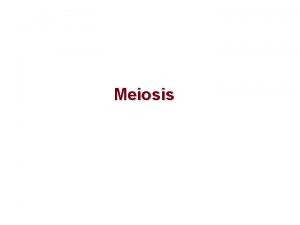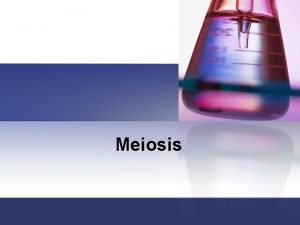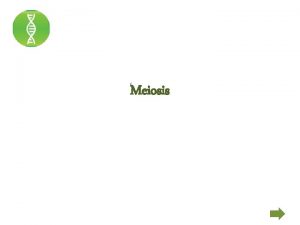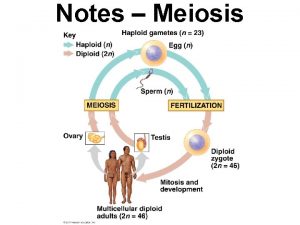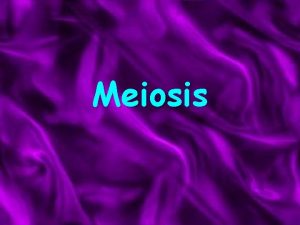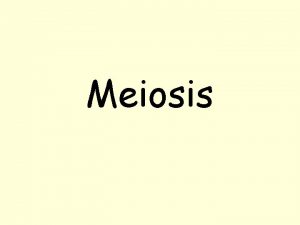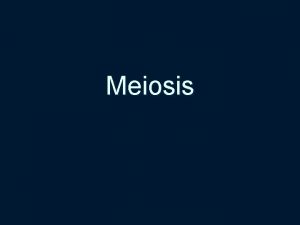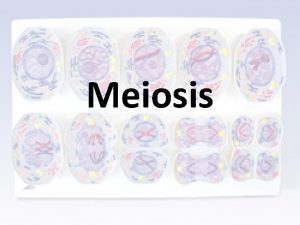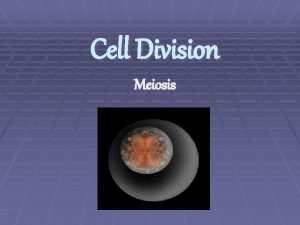Meiosis Heredity and Variation Heredity Is the transmission











































- Slides: 43

Meiosis

Heredity and Variation • Heredity – Is the transmission of traits from one generation to the next • Variation – Shows that offspring differ somewhat in appearance and other traits from parents and siblings • Genetics – Is the scientific study of heredity and hereditary variation

Breeding in English Shepherds Mother Father

Breeding in English Shepherds - Offspring

Genes – A simple definition • Genes – Are the units of heredity – Are segments of DNA • Each gene in an organism’s DNA has a specific locus on a certain chromosome • Sexual organisms inherit one set of chromosomes from the mother and one set from the father

The Shallow End of the Gene Pool

Asexual Reproduction • For example – budding in Hydra is asexual reproduction that forms clones

Asexual Reproduction • Strawberry reproducing by putting out asexual runners – also forming clones

Haploid gametes (n 23) Key Haploid (n) Diploid (2 n) Egg (n) Sperm (n) MEIOSIS Ovary FERTILIZATION Testis Diploid zygote (2 n 46) Mitosis and development Multicellular diploid adults (2 n 46)

Chromosomes • Homologous chromosomes – Are the two chromosomes composing a pair – Have the same characteristics – Autosomes are the non-sex determining chromosomes • Sex chromosomes – Are distinct from each other in their characteristics – Are represented as X and Y in mammals – Determine the sex of the individual, XX being female, XY being male; X and X are homologous in female • A diploid cell – Has two sets of each of its chromosomes – In a human has 46 chromosomes (2 n = 46)


Pair of homologous duplicated chromosomes Centromere Sister chromatids Metaphase chromosome 5 m

Figure 13. x 3 Human female karyotype shown by bright field G-banding of chromosomes

Figure 13. x 5 Human male karyotype shown by bright field G-banding of chromosomes

Hairy Ears – a sex linked trait • Square symbol = male • Round symbol = female • Dark square = hairy ear trait

Chromosome number in humans if there was no meiosis prior to reproduction • First Generation - Sperm and Egg with 46 chromosomes each • Second generation 92 chromosomes • Third generation 184 chromosomes • Fourth generation 368 chromosomes • Etc.


Sexual life cycles Key Haploid (n) Diploid (2 n) n Gametes n Mitosis n MEIOSIS n FERTILIZATION n Diploid multicellular organism (a) Animals Zygote 2 n Mitosis n 2 n Diploid multicellular organism (sporophyte) Mitosis n Spores Gametes MEIOSIS 2 n Haploid unicellular or multicellular organism Haploid multicellular organism (gametophyte) n n Gametes FERTILIZATION (b) Plants and some algae n FERTILIZATION MEIOSIS 2 n Zygote Mitosis 2 n Zygote (c) Most fungi and some protists

Interphase Pair of homologous chromosomes in diploid parent cell Duplicated pair of homologous chromosomes Sister chromatids Chromosomes duplicate Diploid cell with duplicated chromosomes

Interphase Pair of homologous chromosomes in diploid parent cell Duplicated pair of homologous chromosomes Sister chromatids Chromosomes duplicate Diploid cell with duplicated chromosomes Meiosis I 1 Homologous chromosomes separate Haploid cells with duplicated chromosomes

Interphase Pair of homologous chromosomes in diploid parent cell Duplicated pair of homologous chromosomes Sister chromatids Chromosomes duplicate Diploid cell with duplicated chromosomes Meiosis I 1 Homologous chromosomes separate Haploid cells with duplicated chromosomes Meiosis II 2 Sister chromatids separate Haploid cells with unduplicated chromosomes


MEIOSIS I: Separates sister chromatids MEIOSIS I: Separates homologous chromosomes Prophase I Metaphase I Centrosome (with centriole pair) Sister chromatids Chiasmata Fragments of nuclear envelope Duplicated homologous chromosomes (red and blue) pair and exchange segments; 2 n 6 in this example. Prophase II Metaphase II Anaphase II Telophase II and Cytokinesis Sister chromatids remain attached Centromere (with kinetochore) Spindle Homologous chromosomes Telophase I and Cytokinesis Anaphase I Metaphase plate Homologous chromosomes separate Microtubule attached to kinetochore Chromosomes line up by homologous pairs. Cleavage furrow Each pair of homologous chromosomes separates. During another round of cell division, the sister chromatids finally separate; four haploid daughter cells result, containing unduplicated chromosomes. Sister chromatids separate Two haploid cells form; each chromosome still consists of two sister chromatids. Haploid daughter cells forming

Prophase I Centrosome (with centriole pair) Sister chromatids Chiasmata Spindle Telophase I and Cytokinesis Anaphase I Metaphase I Sister chromatids remain attached Centromere (with kinetochore) Metaphase plate Fragments Homologous chromosomes of nuclear envelope Homologous chromosomes separate Microtubule attached to kinetochore Cleavage furrow Each pair of homologous chromosomes separates. Chromosomes line up Duplicated homologous chromosomes (red and blue) by homologous pairs. pair and exchange segments; 2 n 6 in this example. Two haploid cells form; each chromosome still consists of two sister chromatids.

Prophase II Metaphase II Anaphase II Telophase II and Cytokinesis During another round of cell division, the sister chromatids finally separate; four haploid daughter cells result, containing unduplicated chromosomes. Sister chromatids separate Haploid daughter cells forming

MEIOSIS MITOSIS Parent cell MEIOSIS I Chiasma Prophase I Duplicated chromosome Chromosome duplication 2 n 6 Chromosome duplication Homologous chromosome pair Metaphase I Anaphase Telophase Anaphase I Telophase I Daughter cells of meiosis I 2 n Daughter cells of mitosis 2 n Haploid n 3 MEIOSIS II n n Daughter cells of meiosis II

SUMMARY Property Mitosis Meiosis DNA replication Occurs during interphase before mitosis begins Occurs during interphase before meiosis I begins Number of divisions One, including prophase, metaphase, and telophase Two, each including prophase, metaphase, and telophase Synapsis of homologous chromosomes Does not occur Occurs during prophase I along with crossing over between nonsister chromatids; resulting chiasmata hold pairs together due to sister chromatid cohesion Number of daughter cells and genetic composition Two, each diploid (2 n) and genetically identical to the parent cell Four, each haploid (n), containing half as many chromosomes as the parent cell; genetically different from the parent cell and from each other Role in the animal body Enables multicellular adult to arise from zygote; produces cells for growth, repair, and, in some species, asexual reproduction Produces gametes; reduces number of chromosomes by half and introduces genetic variability among the gametes

Independent Assortment Possibility 2 Possibility 1 Two equally probable arrangements of chromosomes at metaphase I

Independent Assortment Possibility 2 Possibility 1 Two equally probable arrangements of chromosomes at metaphase I Metaphase II

Independent Assortment Possibility 2 Possibility 1 Two equally probable arrangements of chromosomes at metaphase I Metaphase II Daughter cells Combination 1 Combination 2 Combination 3 Combination 4

• Mitosis and meiosis have several key differences. – The chromosome number is reduced by half in meiosis, but not in mitosis. – Mitosis produces daughter cells that are genetically identical to the parent and to each other. – Meiosis produces cells that differ from the parent and each other.

• Three events, unique to meiosis, occur during the first division cycle. 1. During prophase I, homologous chromosomes pair up in a process called synapsis. – A protein zipper, the synaptonemal complex, holds homologous chromosomes together tightly. – Later in prophase I, the joined homologous chromosomes are visible as a tetrad. – At X-shaped regions called chiasmata, sections of nonsister chromatids are exchanged. – Chiasmata is the physical manifestation of crossing over, a form of genetic rearrangement. – Prophase I is longest and most important phase

2. At metaphase I homologous pairs of chromosomes, not individual chromosomes are aligned along the metaphase plate. • In humans, you would see 23 tetrads. 3. At anaphase I, it is homologous chromosomes, not sister chromatids, that separate and are carried to opposite poles of the cell. – Sister chromatids remain attached at the centromere until anaphase II. • The processes during the second meiotic division are virtually identical to those of mitosis.

The synaptonemal complex binding together four homologous chromosomes

Chiasmata and crossing over

Prophase I of meiosis Pair of homologs Nonsister chromatids held together during synapsis

Prophase I of meiosis Pair of homologs Chiasma Centromere TEM Nonsister chromatids held together during synapsis

Prophase I of meiosis Pair of homologs Chiasma Centromere TEM Anaphase I Nonsister chromatids held together during synapsis

Prophase I of meiosis Pair of homologs Chiasma Centromere TEM Anaphase II Nonsister chromatids held together during synapsis

Prophase I of meiosis Pair of homologs Nonsister chromatids held together during synapsis Chiasma Centromere TEM Anaphase II Daughter cells Recombinant chromosomes


Human Female vs Male Meiotic Timelines

Sexual reproduction leads to genetic variation via: • Independent assortment during meiosis • Crossing over during meiosis • Random mixing of gametes (sperm and egg)
 Genetics is the study of heredity and variation
Genetics is the study of heredity and variation Concept mapping chapter 10 meiosis 1 and meiosis 2
Concept mapping chapter 10 meiosis 1 and meiosis 2 Differences between mitosis and meiosis
Differences between mitosis and meiosis Chapter 10 meiosis 1 and meiosis 2
Chapter 10 meiosis 1 and meiosis 2 Chapter 10 meiosis 1 and meiosis 2 answer key
Chapter 10 meiosis 1 and meiosis 2 answer key What is a direct variation
What is a direct variation Direct and inverse graphs
Direct and inverse graphs Correlation and regression
Correlation and regression Disvantages of sexual reproduction
Disvantages of sexual reproduction Meisis 1 and 2
Meisis 1 and 2 Telophase 1
Telophase 1 Section 3 mendel and heredity
Section 3 mendel and heredity Chapter 11 complex inheritance and human heredity test
Chapter 11 complex inheritance and human heredity test Chromosome labeled
Chromosome labeled Importance of heredity and environment in education
Importance of heredity and environment in education Section 3 mendel and heredity
Section 3 mendel and heredity Mendel 9 3 3 1
Mendel 9 3 3 1 Section 3 mendel and heredity
Section 3 mendel and heredity Section 3 mendel and heredity
Section 3 mendel and heredity Heredity and crime
Heredity and crime Heredity and environment slideshare
Heredity and environment slideshare Flocabulary genes and heredity answer key
Flocabulary genes and heredity answer key Chapter 17 the beginning of the life cycle
Chapter 17 the beginning of the life cycle Hình ảnh bộ gõ cơ thể búng tay
Hình ảnh bộ gõ cơ thể búng tay Ng-html
Ng-html Bổ thể
Bổ thể Tỉ lệ cơ thể trẻ em
Tỉ lệ cơ thể trẻ em Chó sói
Chó sói Tư thế worm breton là gì
Tư thế worm breton là gì Alleluia hat len nguoi oi
Alleluia hat len nguoi oi Môn thể thao bắt đầu bằng chữ đua
Môn thể thao bắt đầu bằng chữ đua Thế nào là hệ số cao nhất
Thế nào là hệ số cao nhất Các châu lục và đại dương trên thế giới
Các châu lục và đại dương trên thế giới Công thức tiính động năng
Công thức tiính động năng Trời xanh đây là của chúng ta thể thơ
Trời xanh đây là của chúng ta thể thơ Mật thư anh em như thể tay chân
Mật thư anh em như thể tay chân 101012 bằng
101012 bằng độ dài liên kết
độ dài liên kết Các châu lục và đại dương trên thế giới
Các châu lục và đại dương trên thế giới Thể thơ truyền thống
Thể thơ truyền thống Quá trình desamine hóa có thể tạo ra
Quá trình desamine hóa có thể tạo ra Một số thể thơ truyền thống
Một số thể thơ truyền thống Cái miệng nó xinh thế chỉ nói điều hay thôi
Cái miệng nó xinh thế chỉ nói điều hay thôi Vẽ hình chiếu vuông góc của vật thể sau
Vẽ hình chiếu vuông góc của vật thể sau











